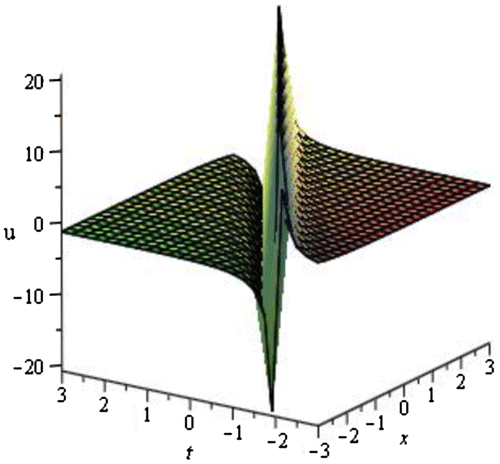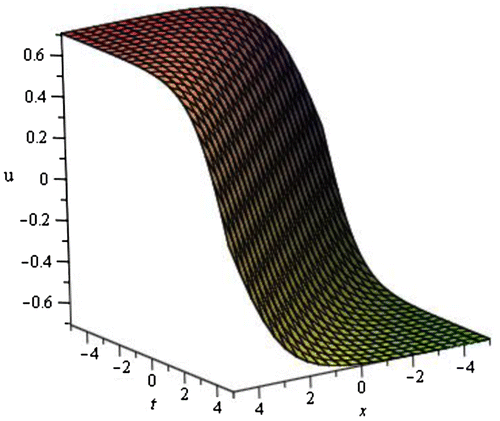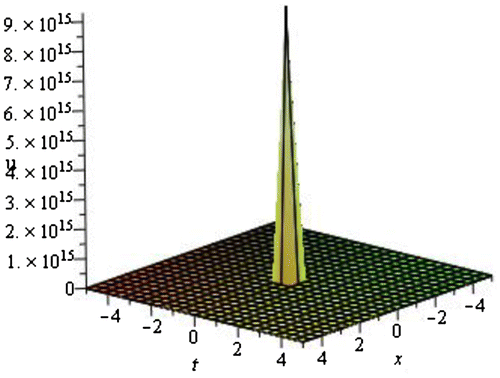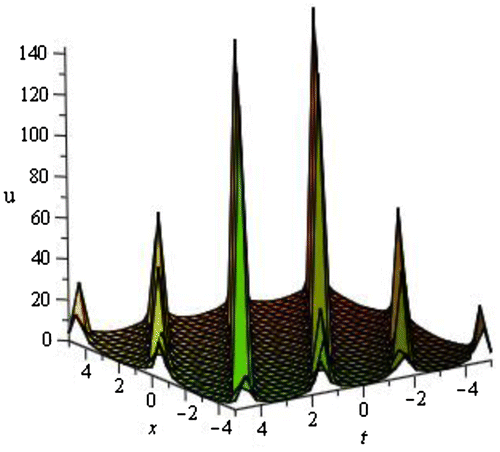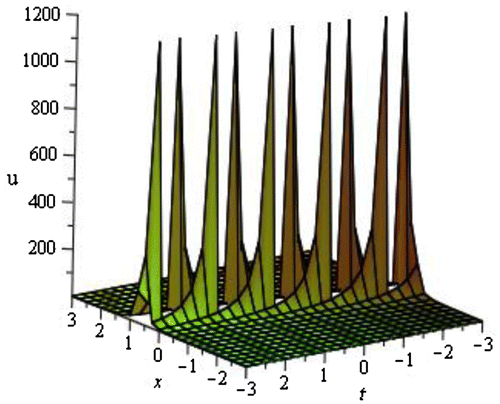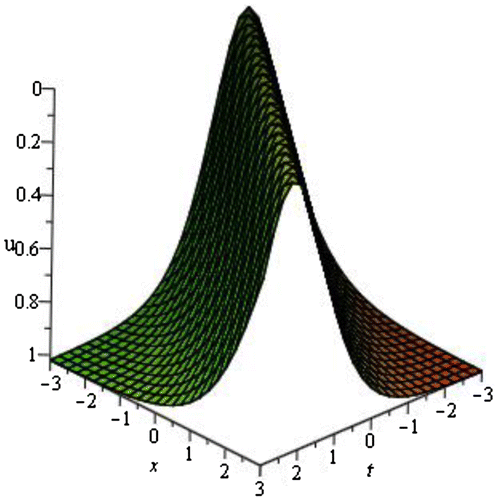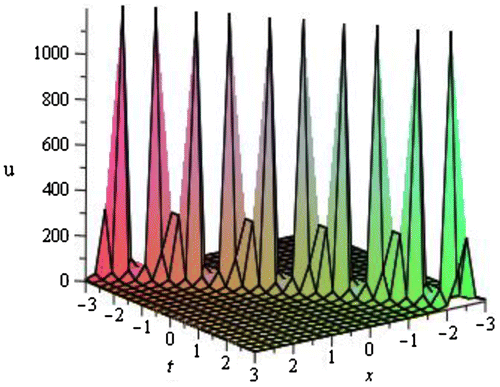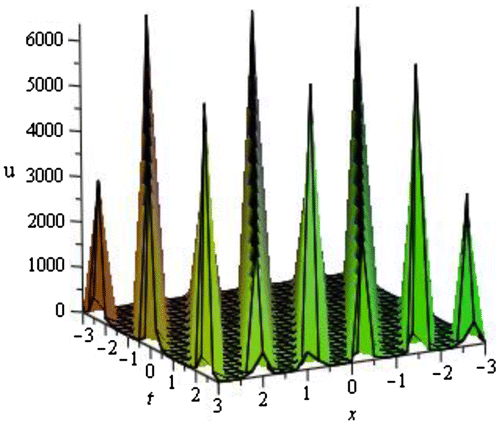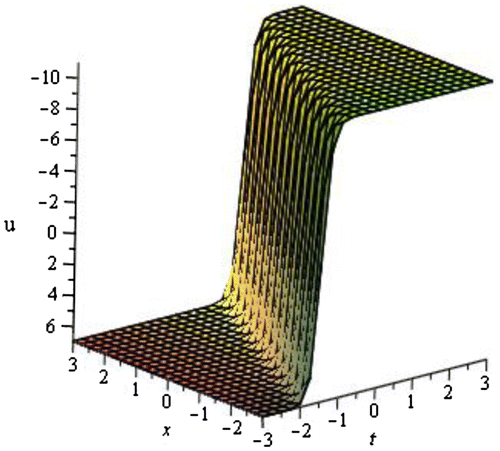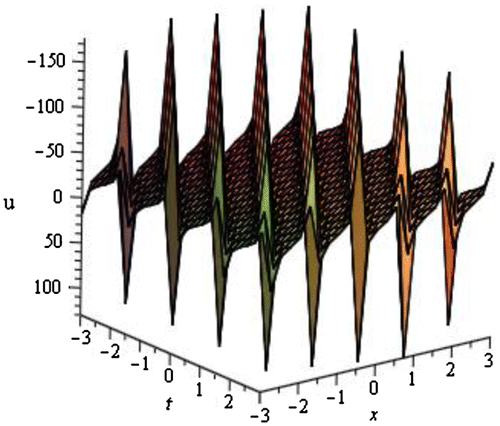 ?Mathematical formulae have been encoded as MathML and are displayed in this HTML version using MathJax in order to improve their display. Uncheck the box to turn MathJax off. This feature requires Javascript. Click on a formula to zoom.
?Mathematical formulae have been encoded as MathML and are displayed in this HTML version using MathJax in order to improve their display. Uncheck the box to turn MathJax off. This feature requires Javascript. Click on a formula to zoom.Abstract
The improved F-expansion method combined with Riccati equation is one of the most effective analytical methods in finding the exact traveling wave solutions to non-linear evolution equations in mathematical physics. In this article, this method is implemented to investigate new exact solutions to the Drinfel’d–Sokolov–Wilson (DSW) equation and the Burgers equation. The performance of this method is reliable, direct, and simple to execute compared to other existing methods. The obtained solutions in this work are imperative and significant for the explanation of some practical physical phenomena.
Public Interest Statement
The modeling of most of the real world phenomena leads to non-linear evolution equations (NLEEs). For better understanding the intricate phenomena, closed form solutions play a vital role. Therefore, diverse group of researchers developed and extended different methods to examine closed form solutions to NLEEs. In this article, we use the improved F-expansion method combined with Riccati equation to investigate closed form wave solutions to the Drinfel’d–Sokolov–Wilson (DSW) equation and the Burgers equation. Thus, we obtain abundant closed form wave solutions of these two equations among them some are new solutions. We expect that the new closed form solutions will be helpful to elucidate the associated phenomena.
1. Introduction
In the field of non-linear science, the investigation of the traveling wave solutions to non-linear evolution equations (NLEEs) plays a significant role in several aspects of mathematical and physical phenomena. Non-linear wave phenomena appear in various scientific and engineering fields such as fluid mechanics, meteorology, optical fibers, biology, solid state physics, chemical kinematics, chemical physics, and geochemistry. Non-linear wave phenomena of dispersion, dissipation, diffusion, reaction, and convection are very significant in non-linear wave equations. Therefore, finding exact solutions to NLEEs has long been one of the most essential areas of research in mathematics and physics. With the development of symbolic computation software like Maple and Mathematica, diverse group of researchers have established many powerful and effective methods in finding analytical and numerical solutions of non-linear equations. The exact solutions of the non-linear equations facilitate the verification of the numerical solvers and aid in the stability analysis of the solutions.
A significant number of methods for the solution of partial differential equations (PDEs) have been established over the last three decades from both theoretical and practical points of view. Improvements in numerical techniques, combine with the advancement of computer technology have meant that many of the PDEs arising from engineering and scientific applications, which were previously intractable, can now be easily solved (Wang, Li, & Zhang, Citation2008). In the last several decades a wide range of methods have been developed to construct traveling solutions to NLEEs such as, the homogeneous balance method (Wang, Citation1996; Wang, Zhou, & Li, Citation1996), the auxiliary equation method (Sirendaoreji, Citation2003; Zhang & Xia, Citation2007), the Exp-function method (Wu & He, Citation2007, 2008), the Darboux transformation method (Hu, Tang, Lou, & Liu, Citation2004; Leble & Ustinov, Citation1993), the tanh-function method (Abdusalam, Citation2005), the modified extended tanh-function method (Lee & Sakthivel, Citation2011), the Jacobi elliptic function method (Liu, Fu, Liu, & Zhao, Citation2001; Parkes, Duffy, & Abbott, Citation2002), the first integral method (Abbasbandy & Shirzadi, Citation2010; Bekir & Ünsal, Citation2012), the modified simple equation method (Jawad, Petkovic, & Biswas, Citation2010; Khan & Akbar, Citation2013a, 2014), the -expansion method (Islam, Khan, Akbar, & Islam, Citation2013; Khan & Akbar, Citation2014a; Kim & Sakthivel, Citation2012; Wang et al., Citation2008), the homotopy perturbation method (Changbum & Rathinasamy, Citation2010; Mohyud-Din, Citation2007; Mohyud-Din & Noor, Citation2009; Mohyud-Din, Yildrim, & Sariaydin, Citation2010; Rathinasamy, Changbum, & Jonu, Citation2010), the
-expansion method (Khan & Akbar, Citation2013b), the variational iteration method (Molliq, Noorani, & Hashim, Citation2009) and the F-expansion method (Hua, Citation2006; Islam, Khan, Akbar, & Mastroberardino, Citation2014; Zhao, Citation2013) etc.
The objective of this article is to implement the improved F-expansion method in constructing the traveling wave solutions to NLEEs in the mathematical physics via the DSW equation and the Burgers equation in terms of functions that satisfy the Riccati equation .
The Burgers equation is the lowest order approximation for the one-dimensional propagation of weak waves in a fluid. It is also used in vehicle density in high way traffic. It is one of the fundamental PDEs in fluid mechanics. Burgers equation is completely integrable. The wave solutions of Burgers equation are single and multiple-front solutions (Wazwaz, Citation2009). The DSW equation is an important wave model in physics (Inc, Citation2006).
The organization of this article is as follows: In Section 2, we will illustrate the improved F-expansion method in detail. In Section 3, the improved F-expansion method is applied to search for the many exact solutions of the DSW equations and the Burgers equation. In Section 4, explanation and graphical representation of some of the attained solutions will be discussed. In Section 5, we include the comparison and conclusions are given in Section 6.
2. The improved F-expansion method
In this section, we describe the improved F-expansion method ornately for seeking the exact traveling wave solutions to NLEEs.
Let us consider a general non-linear evolution equation in the form,(1)
(1)
where is an unknown function, P is a polynomial of
and its partial derivatives in which the highest order partial derivatives and the non-linear terms are involved and the subscripts stands for the partial derivatives.
We introduce the leading steps of the method as follows:
Step-1: In the first step, we make known the traveling wave transformation,(2)
(2)
where is the celerity of the traveling wave. The traveling wave transformation (2), transforms Equation (1) into an ordinary differential equation (ODE) for
:
(3)
(3)
where Q is a polynomial of u and its derivatives and the superscripts indicate the ordinary derivatives with respect to ξ.
Step-2: Equation (3) can possibly be integrated term by term one or more times, to yield constants of integration. The integral constant may be zero for straightforwardness.
Step-3: We assume the traveling wave solution of Equation (3) can be expressed by a polynomial in as follows:
(4)
(4)
where either αN or βN may be zero, but both of them could not be zero at time, and
and m are arbitrary constants to be determined later.
We consider the well-known Riccati equation(5)
(5)
where the prime stands for derivatives with respect to ξ; k is the real parameter.
We now represent the three cases of the general solution of the Riccati equation (5) as follows:
Case-I: When k < 0, the general solutions are:
Case-II: When k > 0, the general solutions are:
Case-III: When k = 0, the general solution is:
Step-4: The positive integer Nis usually obtained by taking the homogeneous balance between the highest order non-linear terms and the derivatives of the highest order appearing in (3). If the degree of u(ξ) is D[u(ξ)] = N, then the degree of the other expressions will be as follows:(6)
(6)
Therefore, we can find the value of N from (4), using Equation (6).
Step-5: Substituting (4) including with Equation (5) into Equation (3) together with the value of Nattained in step 3, we get a polynomials in and
, then collect each coefficient of the resulted polynomial to zero, yields an over-determined set of algebraic equations for αN, βN, m and
.
Step-6: Suppose the value of the constants and
can be determined by solving the algebraic equations attained in step 4. Since the general solution of Equation (5) is well known to us, inserting the value of
and
into Equation (4), we attain more general type and new exact traveling wave solutions of the non-linear partial differential Equation (1).
3. Applications
In this section, we will make use of the improved F-expansion method to find the exact traveling wave solution to the DSW equations and the Burgers equation.
Example 3.1
The Drinfel’d–Sokolov–Wilson (DSW) equation
Let us consider the Drinfel’–-Sokolov–Wilson (DSW) (Khan, Akbar, & Nur Alam, Citation2013) equation in the form:(7)
(7)
where and s are real parameters. This equation was introduced as an important wave model in physics.
We utilize the traveling wave variable to transform the PDE (7) into the ODE,
(8)
(8)
(9)
(9)
where by integrating Equation (8) with respect to ξ once and neglecting the constant of integration, we obtain(10)
(10)
Inserting Equation (9) into Equation (8. 2), we obtain(11)
(11)
Integrating Equation (11) with respect to ξ once and setting the constant of integration to zero, we obtain(12)
(12)
Taking the homogeneous balance between the highest order non-linear term u3 and the derivative term u″ from Equation (12), yields 3 N = N + 2, which gives N = 1.
Hence for N = 1, Equation (4) reduces to(13)
(13)
Now substituting (13) including Equation (5) into Equation (12), we get a polynomial in . Equating the coefficient of the same power of
, we attain the following system of algebraic equations:
From the above system of equations, we get the values of and
:
Set-01:
Set-02:
Set-03:
Set-04:
Set-05:
Case-I: when k < 0, we get the following solutions in terms of hyperbolic functions:
Family-01:
where
Family-02:
where
Family-03:
where
Family-04:
where
Family-05:
where
Case-II: when k > 0, we get the following trigonometric function solutions:
Family-06:
where
Family-07:
where
Family-08:
where
Family-09:
where
Family-10:
where
Remark
All of these obtained solutions have been verified with Maple by substituting them into the original equations and were found correct.
Example 3.2
The Burgers equation
In this subsection, we consider the Burgers equation (Khan & Akbar, Citation2014b) in the form:(14)
(14)
Burgers introduced this equation to capture some of the features of turbulent fluid in a channel by the interaction of the opposite effects of convection and diffusion. It is also used to describe the structure of shock waves, traffic flow, and acoustic transmission. Burgers equation is completely integrable. The wave solutions of Burgers equation are single and multiple-front solutions.
We substitute the traveling wave transformation into Equation (14) and obtained the ordinary differential equation:
(15)
(15)
where prime denotes the derivative with respect to ξ.
Integrating once with respect to ξ, Equation (15) becomes(16)
(16)
where p is the integration constant. Balancing the highest order derivative u′ and the non-linear term u2, we obtain N = 1.
Hence for N = 1 Equation (5) reduces to(17)
(17)
Utilizing (17) including (5) into Equation (16), we get a polynomial in . Equating the coefficient of the same power of
to zero, we attain the following system of algebraic equations:
Solving the above system of equations for and
we get the following values:
Set-01:
Set-02:
Set-03:
Case-I: When k < 0, we get the following hyperbolic function solutions:
Family-01:
where
Family-02:
where
Family-03:
where
Case-II: When k > 0, we get the following trigonometric function solutions:
Family-04:
where
Family-05:
where
Family-06:
where
Case-III: When k = 0, we get the following rational function solutions:
Family-07:
where
Family-08:
where
Family-09:
where
Remark
Again, all of these solutions have been verified with Maple by substituting them into the original equations and were found to be correct.
4. Explanation and graphical representations of the obtained solutions
4.1. Explanation of the obtained solutions
In this section, we will discuss the physical interpretation of the obtained results of the DSW equation and Burgers equation.
4.1.1. Drinfel’d–Sokolov–Wilson equation
We have obtained total of 60 traveling wave solutions in terms of some unknown parameters. These solutions are subdivided into ten families according to the negative and positive values of v and u. The solutions are combinations of hyperbolic functions, trigonometric functions, and rational functions. If we put the particular values of the unknown parameters in each traveling wave solutions, then the solitary waves can be obtained. We have depicted some figure of the solitary waves by setting particular values of unknown parameters.
| • | For the particular values of | ||||
| • | For the particular values of | ||||
| • | For the particular values of | ||||
| • | For the particular values of | ||||
| • | For the particular values of | ||||
| • | For the particular values of | ||||
| • | For the particular values of | ||||
| • | For the particular values of | ||||
4.1.2. Burgers equation
Now we will discuss about the obtained results of the Burgers equation and their graphical representation.
| • | For the particular values of | ||||
| • | For the particular values of | ||||
4.2. Graphical representation of the obtained solutions
The graphical illustrations of the solutions of DSW equations are depicted in Figures – and the solutions of Burgers equations are represented in Figures and with the aid of commercial software Maple.
5. Comparison
In this section, we will discuss the effectiveness of the improved F-expansion method compared to other existing methods.
5.1. DSW equation with the MSE method
In Khan et al. (Citation2013), Khan and Akbar investigated exact solutions of the DSW equations throughout the modified simple equation method and attained 12 solutions (see Appendix A). On the other hand, by adopting the improved F-expansion method in this article we attained 60 solutions. It is remarkable to point out that some of our solutions correspond well with some of the solutions available in the literature, if we put particular values of the parameters which substantiate our solutions. Likewise, if we put in our solutions
(family-01) and
(family-02) correspond with the Equation (A. 1). Also our solutions
(family-01) correspond with the Equation (A. 2) attained by Khan et al. (Citation2013) in place of
. Congruently, for the conditions
our solutions of
and
(family-07) correspond with the Equations (A. 3) and (A. 4), respectively, attained by Khan et al. (Citation2013) in place of
. Yet again if put
in our solutions
and
(family-01) correspond with the Equations (A. 5) and (A. 6), respectively, attained by Inc (Citation2006) in place of
. Congruently, for the conditions
our solutions of
and
(family-04) correspond with the Equations (A. 7) and (A. 8), respectively, attained by Khan et al. (Citation2013) in place of
.
5.2. Burgers equation with modified simple equation method
In Khan and Akbar (Citation2014b) Khan and Akbar studied exact solutions of the Burgers equation by the use of the modified simple equation and attained five solutions (see Appendix B). On the other hand by the improved F-expansion method in this article, we attained 15 solutions. If we put into our solutions
and
correspond with the Equations (B. 1) and (B. 2), respectively, attained by Khan and Akbar (Citation2014b) in place of ω = 1.Congruently, if we put
into our solutions
that coincide with Equation (B. 3) attained by Khan and Akbar (Citation2014b) in place of ω = 1.
6. Conclusions
The improved F-expansion method combined with Riccati equation is used in this article for seeking abundant exact traveling wave solutions to the Drinfel’d–Sokolov–Wilson equation and the Burgers equation with the aid of symbolic computation, such as Maple. The obtained solutions are presented in terms of the hyperbolic functions, the trigonometric functions and the rational functions. Furthermore, our constructed solutions show that the solution procedure of this method is very modest, consistent, and straightforward. If the parameters take special values, we get the existing solitary wave solutions, singular soliton solution, periodic solutions, and kink solutions. The result reveal that the improved F-expansion method is a promising instrument since it can provide a variety of solutions of distinctive physical configurations. This method can also be applied to other non-linear evolution equations (NLEEs) in mathematical physics.
Additional information
Funding
Notes on contributors
M. Ali Akbar
M. Ali Akbar is an Associate Professor at the Department of Applied Mathematics, University of Rajshahi, Bangladesh. He received his PhD in Mathematics from the Department of Mathematics, University of Rajshahi, Bangladesh. He is actively involved in research in the field of nonlinear differential equations and fractional calculus. He has published more than 150 research articles of which 55 articles are published in ISI (Thomson Reuter) indexed journals and other 14 articles published in Scopus indexed journals.
Norhashidah Hj. Mohd. Ali
Norhashidah Hj. Mohd. Ali received her Bachelor of Science (Maths) with a minor in Information Sciences in 1984 from Western Illinois University, USA. In 1986, she received her MSc in Applied Mathematics from Virginia Tech, USA. She completed her PhD in Industrial Computing from Universiti Kebangsaan Malaysia in 1998. She is currently a professor at the School of Mathematical Sciences, Universiti Sains Malaysia. Her research interests include numerical differential equations and parallel processing.
References
- Abbasbandy, S., & Shirzadi, A. (2010). The first integral method for modified Benjamin-Bona-Mahony equation. Communications in Nonlinear Science and Numerical Simulation, 15, 1759–1764.10.1016/j.cnsns.2009.08.003
- Abdusalam, H. A. (2005). On an improved complex tanh-function method. International Journal of Nonlinear Sciences and Numerical Simulation, 6, 99–106.
- Bekir, A., & Ünsal, Ö. (2012). Analytic treatment of nonlinear evolution equations using first integral method. Pramana, 79, 3–17.10.1007/s12043-012-0282-9
- Changbum, C., & Rathinasamy, S. (2010). Homotopy perturbation technique for solving two-point boundary value problems–comparison with other methods. Computer Physics Communications, 181, 1021–1024.
- Hu, H. C., Tang, X. Y., Lou, S. Y., & Liu, Q. P. (2004). Variable separation solutions obtained from Darboux Transformations for the asymmetric Nizhnik–Novikov–Veselov system. Chaos, Solitons & Fractals, 22, 327–334.10.1016/j.chaos.2004.02.002
- Hua, H. W. (2006). A generalized extended f-expansion method and its application in (2+1)-dimensional dispersive long wave equation. Communications in Theoretical Physics, 46, 580.
- Inc, M. (2006). On numerical doubly periodic wave solutions of the coupled Drinfel’d-Sokolov-Wilson equation by the decomposition method. Applied Mathematics and Computation, 172, 421–430.
- Islam, M. E., Khan, K., Akbar, M. A., & Islam, R. (2013). Traveling wave solutions of nonlinear evolution equation via enhanced (G’/G)-expansion method. GANIT: Journal of Bangladesh Mathematical Society, 33, 83–92.
- Islam, M. S., Khan, K., Akbar, M. A., & Mastroberardino, A. (2014). A note on improved F-expansion method combined with Riccati equation applied to nonlinear evolution equations. Royal Society Open Science, 1, 140038. doi:10.1098/rsos.140038
- Jawad, A. J. M., Petkovic, M. D., & Biswas, A. (2010). Modified simple equation method for nonlinear evolution equations. Applied Mathematics and Computation, 217, 869–877.
- Khan, K., & Akbar, M. A. (2013a). Exact and solitary wave solutions for the Tzitzeica–Dodd–Bullough and the modified KdV–Zakharov–Kuznetsov equations using the modified simple equation method. Ain Shams Engineering Journal, 4, 903–909.10.1016/j.asej.2013.01.010
- Khan, K., & Akbar, M. A. (2013b). Application of exp -expansion method to find the exact solutions of modified Benjamin-Bona-Mahony equation. World Applied Sciences Journal, 24, 1373–1377.
- Khan, K., & Akbar, M. A. (2014). Exact Solutions of the (2+1)-dimensional cubic Klein Gordon Equation and the (3+1)-dimensional Zakharov-Kuznetsov Equation Using the Modified Simple Equation Method. Journal of the Association of Arab Universities for Basic and Applied Sciences, 15, 74–81.
- Khan, K., & Akbar, M. A. (2014a). Traveling wave solutions of nonlinear evolution equations via the enhanced (G’/G)-expansion method. Journal of the Egyptian Mathematical Society, 22, 220–226.10.1016/j.joems.2013.07.009
- Khan, K., & Akbar, M. A. (2014b). Traveling wave solutions of the (2+1)-dimensional Zoomeron equation and the Burgers equations via the MSE method and the Exp-function method. Ain Shams Engineering Journal, 5, 247–256.10.1016/j.asej.2013.07.007
- Khan, K., Akbar, M. A., & Nur Alam, M. (2013). Traveling wave solutions of the nonlinear Drinfel’d-Sokolov-Wilson equation and modified Benjamin-Bona-Mahony equations. Journal of the Egyptian Mathematical Society, 21, 233–240.10.1016/j.joems.2013.04.010
- Kim, H., & Sakthivel, R. (2012). New exact traveling wave solutions of some nonlinear higher-dimensional physical models. Reports on Mathematical Physics, 70, 39–50.10.1016/S0034-4877(13)60012-9
- Leble, S. B., & Ustinov, N. V. (1993). Darboux transforms deep reductions and solitons. Journal of Physics A: Mathematical and General, 26, 5007–5016.10.1088/0305-4470/26/19/029
- Lee, J., & Sakthivel, R. (2011). New exact travelling wave solutions of bidirectional wave equations. Pramana, 76, 819–829.10.1007/s12043-011-0105-4
- Liu, S. K., Fu, Z. T., Liu, S. D., & Zhao, Q. (2001). Jacobi elliptic function expansion method and periodic wave solutions of nonlinear wave equations. Physics Letters A, 289, 69–74.10.1016/S0375-9601(01)00580-1
- Mohyud-Din, S. T. (2007). Homotopy perturbation method for solving fourth-order boundary value problems. Mathematical Problems in Engineering, 2007, 1–15.10.1155/2007/98602
- Mohyud-Din, S. T., & Noor, M. A. (2009). Homotopy perturbation method for solving partial differential equations., Zeitschrift für Naturforschung A-A. Journal of Physical Science, 64a, 157–170.
- Mohyud-Din, S. T., Yildrim, A., & Sariaydin, S. (2010). Approximate series solutions of the viscous Cahn-Hilliard equation via the homotopy perturbation method. World Applied Sciences Journal, 11, 813–818.
- Molliq, R. Y., Noorani, M. S. M., & Hashim, I. (2009). Variational iteration method for fractional heat-and wave-like equations. Nonlinear Analysis: Real World Applications, 10, 1854–1869.10.1016/j.nonrwa.2008.02.026
- Parkes, E. J., Duffy, B. R., & Abbott, P. C. (2002). The Jacobi elliptic-function method for finding periodic-wave solutions to nonlinear evolution equations. Physics Letters A, 295, 280–286.10.1016/S0375-9601(02)00180-9
- Rathinasamy, S., Changbum, C., & Jonu, L. (2010). New travelling wave solutions of burgers equation with finite transport memory. Zeitschrift fur Naturforschung-A, 65, 633–640.
- Sirendaoreji, J. S. (2003). Auxiliary equation method for solving nonlinear partial differential equations. Physics Letters A, 309, 387–396.10.1016/S0375-9601(03)00196-8
- Wang, M., Li, X., & Zhang, J. (2008). The ()-expansion method and travelling wave solutions of nonlinear evolution equations in mathematical physics. Physics Letters A, 372, 417–423.10.1016/j.physleta.2007.07.051
- Wang, M. L. (1996). Exact solutions for a compound KdV-Burgers equation. Physics Letters A, 213, 279–287.10.1016/0375-9601(96)00103-X
- Wang, M. L., Zhou, Y. B., & Li, Z. B. (1996). Application of a homogeneous balance method to exact solutions of nonlinear equations in mathematical physics. Physics Letters A, 216, 67–75.10.1016/0375-9601(96)00283-6
- Wazwaz, A. M. (2009). Partia l differential equations and solitary waves theory. Berlin & Heidelberg: Higher Education Press & Beijing and Springer-Verlag.10.1007/978-3-642-00251-9
- Wu, X. H., & He, J. H. (2007). Solitary solutions, periodic solutions and compacton-like solutions using the Exp-function method. Computers & Mathematics with Applications, 54, 966–986.10.1016/j.camwa.2006.12.041
- Wu, X. H., & He, J. H. (2008). EXP-function method and its application to nonlinear equations. Chaos, Solitons & Fractals, 38, 903–910.
- Zhang, S., & Xia, T. C. (2007). A generalized new auxiliary equation method and its applications to nonlinear partial differential equations. Physics Letters A, 363, 356–360.10.1016/j.physleta.2006.11.035
- Zhao, Y. M. (2013). F-expansion method and its application for finding new exact solutions to the Kudryashov-Sinelshchikov equation. Journal of Applied Mathematics, 2013, 8.
Appendix A
Khan et al. (Citation2013) examined the exact solutions of the DSW equation via the modified Simple equation method. They obtained the following solutions(A.1)
(A.1)
(A. 2)
(A. 2)
(A. 3)
(A. 3)
(A. 4)
(A. 4)
(A. 5)
(A. 5)
(A. 6)
(A. 6)
(A. 7)
(A. 7)
(A. 8)
(A. 8)
Appendix B
Khan & Akbar (Citation2014b) studied the exact solutions of the Burgers equation with the support of the modified simple equation method. They projected the following solutions,(B. 1)
(B. 1)
(B. 2)
(B. 2)
(B. 3)
(B. 3)
(B. 4)
(B. 4)
(B.5)
(B.5)

